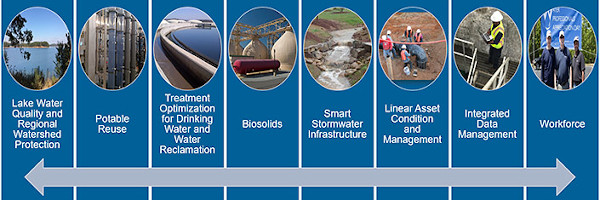Non-Revenue Water Monitoring and Reduction Using Advanced LTE Communications Gwinnet County GA
| Non-Revenue Water Monitoring and Reduction Using Advanced LTE Communications Gwinnet County GA | |
|---|---|

| |
 Water Monitoring | |
| Team Organizations | Jacobs Qualcomm ATT Neptune Meters Capstone Meters Trimble/Telog Krohne Fathom |
| Team Leaders | Kenneth Thompson |
| Participating Municipalities | Gwinnett County GA |
| Status | Development |
| Document | None |
Description
Install the first LTE communications base instrumentation in a pilot area and develop algorithms for understanding the elements of non-revenue water (lost water) as a means to reduce the cost of water delivery, improve management of scarce water resources, improve system operations, and save money for customers. The pilot will use advanced instrumentation with embedded LTE communications chips, such as smart water meters and pressure sensors to produce data to be used in the development of the software algorithms.
Challenges
- Development of advanced non-revenue water algorithms
- Correlating data with real water loss (pipeline leaks, theft, inaccurate metering) to verify algorithms
Solutions
TBD
Major Requirements
- Identify the pilot location
- Procure and install smart meters and pressure sensors
- Develop a baseline for water flow and pressure being served to the pilot area
- Develop algorithms for:
- Individual meter demand profiles and system wide demand profile
- Real water loss
- Real time assessment to differentiate between leaks, theft and inaccurate meter reads
- Validate algorithms
Performance Targets
| Key Performance Indicators (KPIs) | Measurement Methods |
|---|---|
|
|
Standards, Replicability, Scalability, and Sustainability
- Use of open standards for data transfer, analytics software, and visualization tools
- Use of cellular standards for 3G and LTE
- The total system approach that is developed could be readily modified for use in other water distribution systems worldwide
Cybersecurity and Privacy
TBD
Impacts
- Reduction in energy use for drinking water treatment and distribution associated with water reduction
- Reduction in use of chemicals and residuals for water treatment associated with water reduction
- Reduction in cost of water treatment and distribution associated with water reduction
Demonstration/Deployment
- Phase I Pilot/Demonstration:
Pilot area defined and DMA meter serving the pilot area installed. Baseline established for water being served into the pilot area and compared with amount being currently billed to the customers to establish baseline NRW. Pressure sensors installed and baseline established for pressure profile in the pilot area.
- Phase II Deployment:
All smart meters installed. Algorithms developed and validated. Enhanced pressure profile developed. Reports produced defining the approach and savings in energy, chemicals and cost.